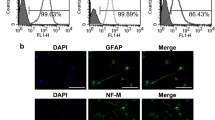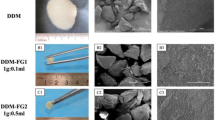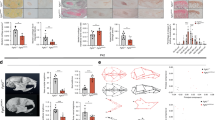Abstract
Metaphyseal dysplasia with maxillary hypoplasia and brachydactyly (MDMHB) is an autosomal-dominant skeletal dysplasia characterised by metaphyseal flaring of the long bones, enlargement of the medial halves of the clavicles, maxillary hypoplasia, brachydactyly, dental anomalies and mild osteoporosis. To date, only one large French Canadian family and a Finnish woman have been reported with the condition. In both, intragenic duplication encompassing exons 3–5 of the RUNX2 gene was identified. We describe a new, three-generation family with clinical features of MDMHB and an intragenic tandem duplication of RUNX2 exons 3–6. Dental problems were the primary presenting feature in all four affected individuals. We compare the features in our family to those previously reported in MDMHB, review the natural history of this condition and highlight the importance of considering an underlying skeletal dysplasia in patients presenting with significant dental problems and other suggestive features, including disproportionate short stature and/or digital anomalies.
Similar content being viewed by others
Log in or create a free account to read this content
Gain free access to this article, as well as selected content from this journal and more on nature.com
or
References
Halal F, Picard JL, Raymond‐Tremblay D, de Bosset P, Opitz JM. Metaphyseal dysplasia with maxillary hypoplasia and brachydactyly. Am J Med Genet. 1982;13:71–9.
Moffatt P, Amor MB, Glorieux FH, et al. Metaphyseal dysplasia with maxillary hypoplasia and brachydactyly is caused by a duplication in RUNX2. Am J Hum Genet. 2013;92:252–8.
Avela K, Hirvinen H, Amor MB, Rauch F. Metaphyseal dysplasia with maxillary hypoplasia and brachydactyly in a Finnish woman: first confirmation of a duplication in RUNX2 as pathogenic variant. Eur J Med Genet. 2014;57:617–20.
Stein GS, Lain JB, van Wijen AJ, et al. Runx2 control of organization, assembly and activity of the regulatory machinery for skeletal gene expression. Oncogene. 2004;23:4315–29.
Zhang YD, Chen Z, Song YQ, Liu C, Chen YP. Making a tooth: growth factors, transcription factors and stem cells. Cell Res. 2005;15:301–16.
Komori T, Yagi H, Nomura S, et al. Targeted disruption of Cfba1 results in a complete lack of bone formation owing to maturational arrest of osteoblasts. Cell. 1997;89:755–64.
Otto F, Thornell AP, Crompton T, et al. Cfba1, a candidate gene for cleidocranial dysplasia syndrome, is essential for osteoblast differentiation and bone development. Cell. 1997;89:765–71.
D’Souza RN, Aberg T, Gaikwad J, et al. Cfba1 is required for epithelial-mesenchymal interactions regulating tooth development in mice. Development. 1999;126:2911–20.
He N, Xiao Z, Yin T, et al. Inducible expression of Runx2 results in multiorgan abnormalities in mice. J Cell Bichem. 2011;112:653–65.
Mefford HC, Shafer N, Antonacci F, et al. Copy number variation analysis in single-suture craniosynostosis: multiple rare variants including RUNX2 duplication in two cousins with metopic craniosynostosis. Am J Med Genet. 2010;152A:2203–10.
Mundlos S, Otto F, Mundlos C, et al. Mutations involving the transcription factor CBFA1 cause cleidocranial dysplasia. Cell. 1997;89:773–9.
Ye X, Song G, Fan M, et al. A novel heterozygous deletion in the EVC2 gene causes Weyers acrofacial dysostosis. Hum Genet. 2006;119:199–205.
Price JA, Bowden DW, Wright JT, Pettenati MJ, Hart TC. Identification of a mutation in DLX3 associated with tricho-dento-osseous (TDO) syndrome. Hum Mol Genet. 1998;7:563–9.
Verloes A, Jamblin P, Koulischer L, Bourguignon JP. A new form of skeletal dysplasia with amelogenesis imperfecta and platyspondyly. Clin Genet. 1996;49:2–5.
Elalaoui SC, Al-Shegaih N, Ratbi I, et al. Non lethal Raine syndrome and differential diagnosis. Eur J Med Genet. 2016;59:577–83.
Acknowledgements
We thank Professor Andrew Wilke, Professor of Genetics at the University of Oxford, for his advice regarding the functional significance of the RUNX2 intragenic duplication identified in our family.
Author information
Authors and Affiliations
Corresponding author
Ethics declarations
Conflict of interest
The authors declare that they have no conflict of interest.
Rights and permissions
About this article
Cite this article
Al-Yassin, A., Calder, A.D., Harrison, M. et al. A three-generation family with metaphyseal dysplasia, maxillary hypoplasia and brachydactyly (MDMHB) due to intragenic RUNX2 duplication. Eur J Hum Genet 26, 1288–1293 (2018). https://doi.org/10.1038/s41431-018-0166-7
Received:
Revised:
Accepted:
Published:
Issue date:
DOI: https://doi.org/10.1038/s41431-018-0166-7



